Energy Dissipation and Damage Evolution during Dynamic Fracture of Muddy Siltstones Containing Initial Damage under the Freeze Thaw Effect
Abstract
1. Introduction
2. Materials and Methods
2.1. Materials
2.2. Test Device
2.3. Test Schemes
- (1)
- Impact tests were performed on the rock specimens meeting the test requirements. The rock specimens were damaged when the incident-wave amplitude was 80 to 85 mV. The intact rock specimens (without initial damage) were impacted under 50%, 60%, 70%, and 80% of such an incident-wave amplitude to form the rock specimens containing different levels of initial damage, corresponding to levels I, II, III, and IV of initial damage. The changes in the incident energy and damage stress of the rock specimens containing initial damage are shown in Figure 3. At the four levels of initial damage, the average incident energy of the rock is 6.58 J, 11.96 J, 15.30 J, and 20.89 J and the average damage stress is 9.80 MPa, 17.00 MPa, 23.34 MPa, and 32.54 MPa, respectively.
- (2)
- Intact rock specimens and saturated rock specimens containing different levels of initial damage were subjected to 0, 5, 10, 15, 20, 25, 30, and 40 F-T cycles under conditions of freezing and thawing both for 12 h within a F-T temperature range from −20 to 20 °C. The cyclic F-T process is shown in Figure 4.
- (3)
- The rock specimens treated as described above were subjected to dynamic compression tests under the same conditions.
3. Test Results and Analysis
3.1. Dynamic Properties
3.2. Energy Dissipation
3.3. Damage Evolution Characteristics
3.4. Fractal Features of Rock Fragments
4. Conclusions
- (1)
- The dynamic compressive strength of the muddy siltstones under the F-T effect shows a decreasing trend with the increasing level of initial damage. After 40 F-T cycles, the peak strength of the intact rock and rock specimens containing level-I, II, III, and IV initial damage decreases by 54.9%, 48.4%, 39.4%, 42.5%, and 44.5%, respectively, compared with that before freezing and thawing. The presence of initial damage exerts significant influences on the strength and rate of deterioration of the rock under the F-T effect.
- (2)
- The absorbed energy and transmitted energy of the muddy siltstones reduce, while the reflected energy gradually increases, with the increasing number of F-T cycles. The presence of initial damage causes obvious step-like changes of the energy distribution. After 20 F-T cycles, the decrease in the absorbed energy in the rock gradually slows and less energy is needed for fracture. At the same time, the difference between the steps of the transmitted energy and reflected energy gradually narrows. After a given number of F-T cycles, the time to the decrease in amplitude of absorbed energy in the rock is advanced with the increasing level of initial damage. The presence of initial damage facilitates the deterioration efficiency of the rock due to the F-T effect and reduces the number of F-T cycles that cause the same amount of damage.
- (3)
- The damage variable of the muddy siltstones shows an exponential increase trend with the increasing number of F-T cycles. Under the F-T effect, the rate of growth of the damage variable of the rock diminishes with the increasing level of initial damage. The initial damage does not directly promote the evolution of damage in the muddy siltstones under the F-T effect but does increase the extent of the damage accumulation of the rock in that time with no F-T cycling, thus indirectly accelerating the F-T deterioration efficiency. With the gradual increase in the level of initial damage, the skeleton structure of the rock is deteriorated, and it is more difficult for the F-T damage to be further superimposed thereon.
- (4)
- Under the F-T effect, the energy absorption density of the muddy siltstones containing initial damage gradually decreases with the increasing damage variable. The energy absorption density reduces by 67% when the damage variable is between 0.73 and 0.97. When the damage accumulation in the muddy siltstones exceeds a certain amount, the skeleton structure of the rock is deteriorated and the rock undergoes low-energy fatigue, eventually leading to severe damage at failure.
- (5)
- The fractal dimension of the muddy siltstones containing different levels of initial damage gradually increases with the increasing number of F-T cycles and damage variable, while it exhibits an inverse relationship with the energy absorption density. The fractal dimension of the muddy siltstones increases significantly when the damage variable is within the range from 0.73 to 0.97.
Author Contributions
Funding
Institutional Review Board Statement
Informed Consent Statement
Data Availability Statement
Conflicts of Interest
References
- Song, Z.; Wang, Y.; Konietzky, H.; Cai, X. Mechanical behavior of marble exposed to freeze-thaw-fatigue loading. Int. J. Rock Mech. Min. Sci. 2021, 138, 104648. [Google Scholar] [CrossRef]
- Jia, H.; Ding, S.; Zi, F.; Dong, Y.; Shen, Y. Evolution in sandstone pore structures with freeze-thaw cycling and interpretation of damage mechanisms in saturated porous rocks. Catena 2020, 195, 104915. [Google Scholar] [CrossRef]
- Ding, S.; Jia, H.; Zi, F.; Dong, Y.; Yao, Y. Frost Damage in Tight Sandstone: Experimental Evaluation and Interpretation of Damage Mechanisms. Materials 2020, 13, 4617. [Google Scholar] [CrossRef] [PubMed]
- Niu, F.; Hu, H.; Liu, M.; Ma, Q.; Su, W. Studies for Frost Heave Characteristics and the Prevention of the High-Speed Railway Roadbed in the Zoige Wetland, China. Front. Earth Sci. 2021, 9, 570. [Google Scholar] [CrossRef]
- Li, A.; Niu, F.; Xia, C.; Bao, C.; Zheng, H. Water migration and deformation during freeze-thaw of crushed rock layer in Chinese high-speed railway subgrade: Large scale experiments. Cold Reg. Sci. Technol. 2019, 166, 102841. [Google Scholar] [CrossRef]
- Zhang, J.; Zhang, X.; Fu, H.; Wu, Y.; Huang, Z.; Chen, D. An Analytical Solution for the Frost Heaving Force considering the Freeze-Thaw Damage and Transversely Isotropic Characteristics of the Surrounding Rock in Cold-Region Tunnels. Adv. Civ. Eng. 2020, 2020, 1–15. [Google Scholar] [CrossRef]
- Yahaghi, J.; Liu, H.; Chan, A.; Fukuda, D. Experimental and numerical studies on failure behaviours of sandstones subject to freeze-thaw cycles. Transp. Geotech. 2021, 31, 100655. [Google Scholar] [CrossRef]
- Fu, H.; Zhang, J.; Huang, Z.; Shi, Y.; Wang, J. Experimental investigations on the elastic parameters and uniaxial compressive strength of slate under freeze–thaw cycles. Geomech. Geoengin. 2019, 14, 285–296. [Google Scholar] [CrossRef]
- Yang, C.; Zhou, K.; Xiong, X.; Deng, H.; Pan, Z. Experimental investigation on rock mechanical properties and infrared radiation characteristics with freeze-thaw cycle treatment. Cold Reg. Sci. Technol. 2021, 183, 103232. [Google Scholar] [CrossRef]
- Tan, X.; Chen, W.; Yang, J.; Cao, J. Laboratory investigations on the mechanical property degradation of granite under freeze–thaw cycles. Cold Reg. Sci. Technol. 2011, 68, 130–138. [Google Scholar] [CrossRef]
- Shi, L.; Liu, Y.; Meng, X.; Zhang, H. Study on Mechanical Properties and Damage Characteristics of Red Sandstone under Freeze-thaw and Load. Adv. Civ. Eng. 2021, 2021, 1–13. [Google Scholar] [CrossRef]
- Momeni, A.A.; Abdilor, Y.; Khanlari, G.R.; Heidari, M.; Sepahi, A.A. The effect of freeze–thaw cycles on physical and mechanical properties of granitoid hard rocks. B. Eng. Geol. Environ. 2015, 75, 1649–1656. [Google Scholar] [CrossRef]
- Prick, A. Critical degree of saturation as a threshold moisture level in frost weathering of limestones. Permafr. Periglac. Process. 1997, 8, 91–99. [Google Scholar] [CrossRef]
- Jia, H.; Ding, S.; Wang, Y.; Zi, F.; Sun, Q.; Yang, G. An NMR-based investigation of pore water freezing process in sandstone. Cold Reg. Sci. Technol. 2019, 168, 102893. [Google Scholar] [CrossRef]
- Liu, Y.; Cai, Y.C.; Huang, S.; Guo, Y.; Liu, G. Effect of water saturation on uniaxial compressive strength and damage degree of clay-bearing sandstone under freeze-thaw. Bull. Eng. Geol. Environ. 2019, 79, 2021–2036. [Google Scholar] [CrossRef]
- Weng, L.; Wu, Z.; Taheri, A.; Liu, Q.; Lu, H. Deterioration of dynamic mechanical properties of granite due to freeze-thaw weathering: Considering the effects of moisture conditions. Cold Reg. Sci. Technol. 2020, 176, 103092. [Google Scholar] [CrossRef]
- Zhang, Q.; Zhao, J. A Review of Dynamic Experimental Techniques and Mechanical Behaviour of Rock Materials. Rock Mech. Rock Eng. 2013, 47, 1411–1478. [Google Scholar] [CrossRef]
- Zhou, Y.; Xia, K.; Li, X.; Li, H.; Ma, G.; Zhao, J.; Zhou, Z.; Dai, F. Suggested Methods for Determining the Dynamic Strength Parameters and Mode-I Fracture Toughness of Rock Materials. Int. J. Rock Mech. Min. 2012, 49, 105–112. [Google Scholar] [CrossRef]
- Yan, F.; Jiang, F. Experiment on rock damage under blasting load. Explos. Shock Waves 2009, 29, 275–280. (In Chinese) [Google Scholar] [CrossRef]
- Doan, M.; D’hour, V. Effect of initial damage on rock pulverization along faults. J. Struct. Geol. 2012, 45, 113–124. [Google Scholar] [CrossRef]
- Li, J.; Deng, S.; Wang, M.; Huang, H. Weak disturbance-triggered seismic events: An experimental and numerical investigation. B. Eng. Geol. Environ. 2018, 78, 2943–2955. [Google Scholar] [CrossRef]
- Bayram, F. Predicting mechanical strength loss of natural stones after freeze–thaw in cold regions. Cold Reg. Sci. Technol. 2012, 83, 98–102. [Google Scholar] [CrossRef]
- Xu, J.; Pu, H.; Sha, Z. Mechanical behavior and decay model of the sandstone in Urumqi under coupling of freeze–thaw and dynamic loading. B. Eng. Geol. Environ. 2021, 80, 2963–2978. [Google Scholar] [CrossRef]
- Luo, Y.; Qu, D.; Wang, G.; Li, X.; Zhang, G. Degradation model of the dynamic mechanical properties and damage failure law of sandstone under freeze-thaw action. Soil Dyn. Earthq. Eng. 2020, 132, 106094. [Google Scholar] [CrossRef]
- Ke, B.; Zhang, J.; Deng, H.; Yang, X. Dynamic Characteristics of Sandstone under Coupled Static-Dynamic Loads after Freeze-Thaw Cycles. Appl. Sci. 2020, 10, 3351. [Google Scholar] [CrossRef]
- Pu, Q.; Huang, J.; Zeng, F.; Luo, Y.; Li, X.; Zhou, J.; Zheng, S. Study on Long-Term Dynamic Mechanical Properties and Degradation Law of Sandstone under Freeze-Thaw Cycle. Shock Vib. 2020, 2020, 1–10. [Google Scholar] [CrossRef]
- Zhou, K.; Li, B.; Li, J.; Deng, H.; Bin, F. Microscopic damage and dynamic mechanical properties of rock under freeze–thaw environment. Trans. Nonferrous Met. Soc. China 2015, 25, 1254–1261. [Google Scholar] [CrossRef]
- Xie, H.; Li, L.; Peng, R.D.; Ju, Y. Energy analysis and criteria for structural failure of rocks. J. Rock Mech. Geotech. 2009, 1, 11–20. [Google Scholar] [CrossRef]
- Deng, Y.; Chen, M.; Jin, Y.; Zou, D. Theoretical analysis and experimental research on the energy dissipation of rock crushing based on fractal theory. J. Nat. Gas Sci. Eng. 2016, 33, 231–239. [Google Scholar] [CrossRef]
- Zhang, J.; Deng, H.; Taheri, A.; Ke, B.; Liu, C. Deterioration and strain energy development of sandstones under quasi-static and dynamic loading after freeze-thaw cycles. Cold Reg. Sci. Technol. 2019, 160, 252–264. [Google Scholar] [CrossRef]
- Ma, Q.; Ma, D.; Yao, Z.M. Influence of freeze-thaw cycles on dynamic compressive strength and energy distribution of soft rock specimen. Cold Reg. Sci. Technol. 2018, 153, 10–17. [Google Scholar] [CrossRef]
- Song, L.; Hu, S.S. Two wave and three wave method in SHPB data processing. Explos. Shock Waves 2005, 25, 368–373. (In Chinese) [Google Scholar] [CrossRef]
- Zhou, Z.; Cai, X.; Zhao, Y.; Chen, L.; Xiong, C.; Xibing, L. Strength characteristics of dry and saturated rock at different strain rates. Trans. Nonferrous Met. Soc. China 2016, 26, 1919–1925. [Google Scholar] [CrossRef]
- Zhang, X.; Chiu, Y.W.; Hao, H.; Hsieh, A.; Dight, P.; Liu, K. Dynamic compressive properties of Kalgoorlie basalt rock. Int. J. Rock Mech. Min. 2020, 135, 104512. [Google Scholar] [CrossRef]
- Mahanta, B.; Singh, T.N.; Ranjith, P.G.; Vishal, V. Experimental investigation of the influence of strain rate on strength; failure attributes and mechanism of Jhiri shale. J. Nat. Gas Sci. Eng. 2018, 58, 178–188. [Google Scholar] [CrossRef]
- Meng, F.; Zhai, Y.; Li, Y.; Li, Y.; Zhang, Y. Experimental study on dynamic tensile properties and energy evolution of sandstone after freeze-thaw cycles. Rock Soil Mech. 2021, 40, 2445–2453. (In Chinese) [Google Scholar] [CrossRef]
- Wang, L.L. Foundation of Stress Waves; Elsevier: Amsterdam, The Netherlands, 2011; pp. 56–201. [Google Scholar]
- Villar, M.V.; Lloret, A. Influence of temperature on the hydro-mechanical behaviour of a compacted bentonite. Appl. Clay Sci. 2004, 26, 337–350. [Google Scholar] [CrossRef]
- Jin, J.; Li, X.; Yin, Z.; Zou, Y. A method for defining rock damage variable by wave impedance under cyclic impact loadings. Rock Soil Mech. 2011, 32, 1385–1393. (In Chinese) [Google Scholar] [CrossRef]
- Wang, P.; Xu, J.; Xinyu, F.; Peixi, W. Energy dissipation and damage evolution analyses for the dynamic compression failure process of red-sandstone after freeze-thaw cycles. Eng. Geol. 2017, 221, 104–113. [Google Scholar] [CrossRef]
- Liu, S.; Xu, J.; Wang, P.; Liu, S. A SHPB experimental study and microscopic analysis of freeze-thaw red sandstone. J. Vib. Shock. 2017, 36, 203–209. (In Chinese) [Google Scholar] [CrossRef]
- Niu, C.; Zhu, Z.; Zhou, L.; Li, X.; Ying, P.; Dong, Y.; Deng, S. Study on the microscopic damage evolution and dynamic fracture properties of sandstone under freeze-thaw cycles. Cold Reg. Sci. Technol. 2021, 191, 103328. [Google Scholar] [CrossRef]
- Xie, H. An Introduction to Fractal Rock Mechanics; Beijing Science Publisher: Beijing, China, 1996; pp. 100–164. (In Chinese) [Google Scholar]
- Song, Y.; Yang, H.; Tan, H.; Ren, J.; Guo, X. Study on damage evolution characteristics of sandstone with different saturations in freeze-thaw environment. J Rock Mech. Eng. 2021, 40, 1513–1524. (In Chinese) [Google Scholar] [CrossRef]
- Li, J.; Zhou, K.; Liu, W.; Deng, H. NMR research on deterioration characteristics of microscopic structure of sandstones in freeze–thaw cycles. Trans. Nonferrous Met. Soc. China 2016, 26, 2997–3003. [Google Scholar] [CrossRef]
- Yang, Y.; Wang, J.; Yang, R.; Fang, S.; Zhang, N.; Guo, Y. Analysis of deformation and fracture of the saturated frozen red sandstone under high strain rate. J. Rock Mech. Eng. 2018, 37, 4016–4026. (In Chinese) [Google Scholar] [CrossRef]
- Wang, L.; Yuan, Q.; Xie, G.; Gu, S.; Jiao, Z.; Liu, H.; Chen, L. Length-diameter ratio effect of energy dissipation and fractals of coal samples under impact loading. J. Chin. Coal Soc. 2022, 47, 1534–1546. (In Chinese) [Google Scholar] [CrossRef]
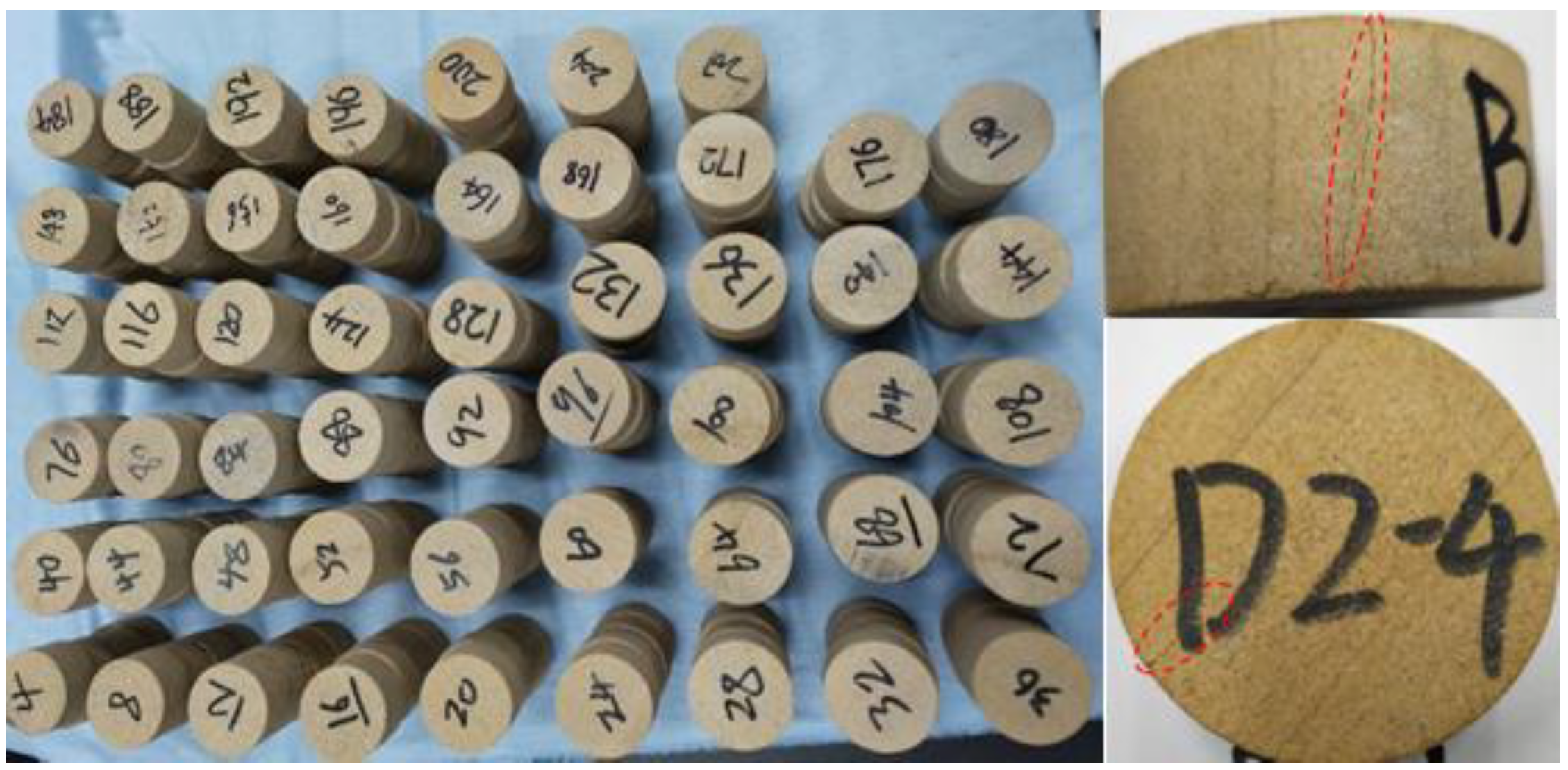

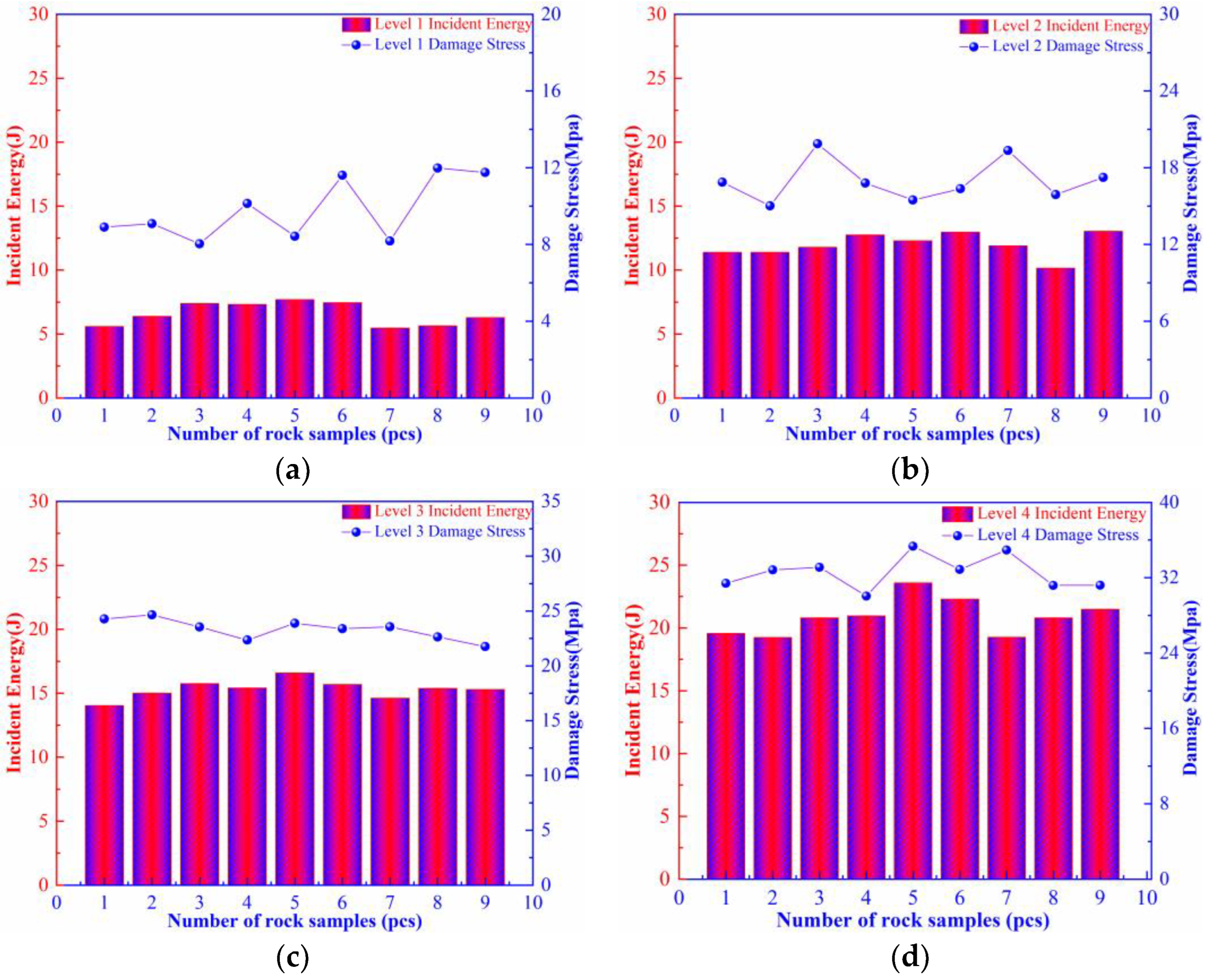

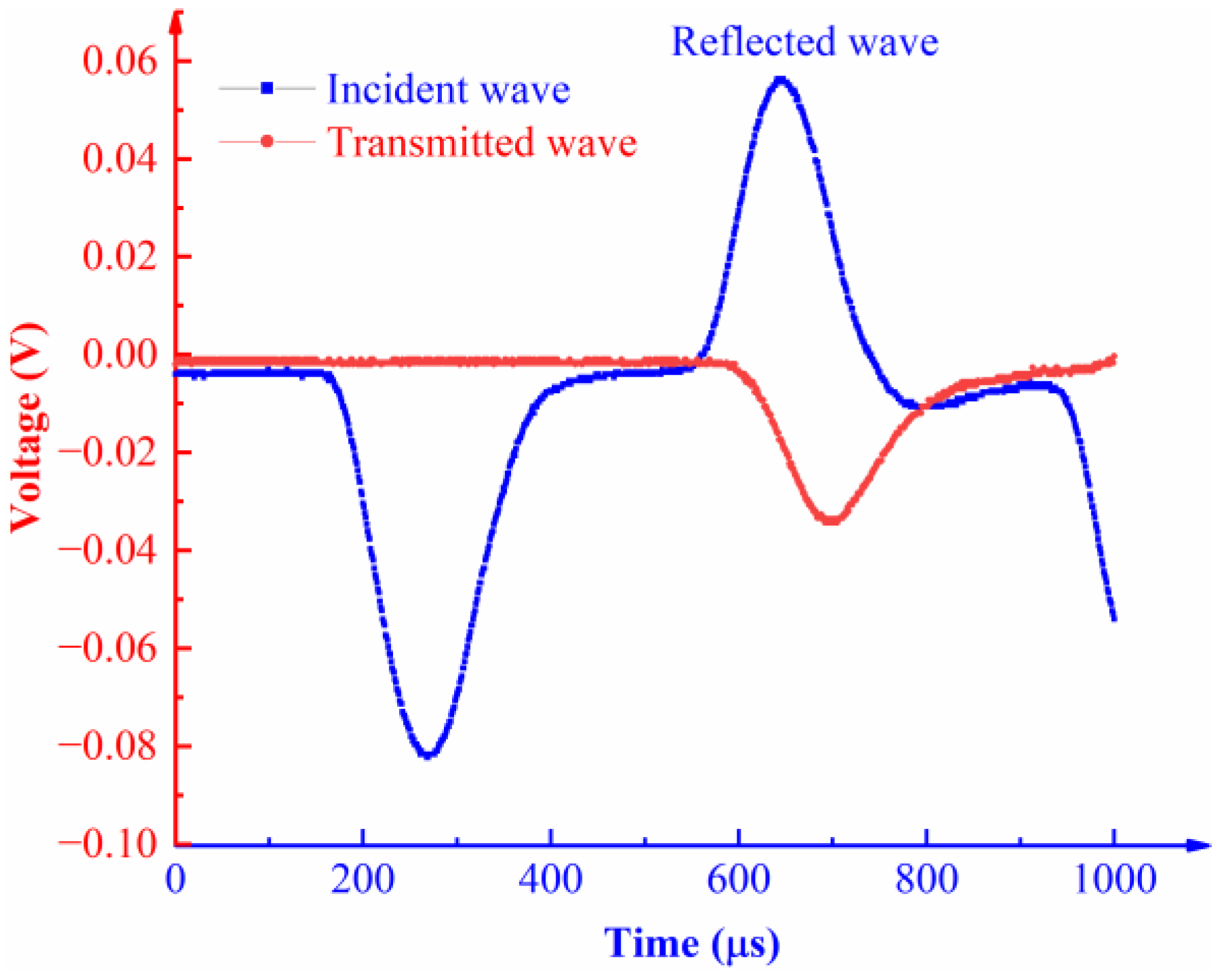
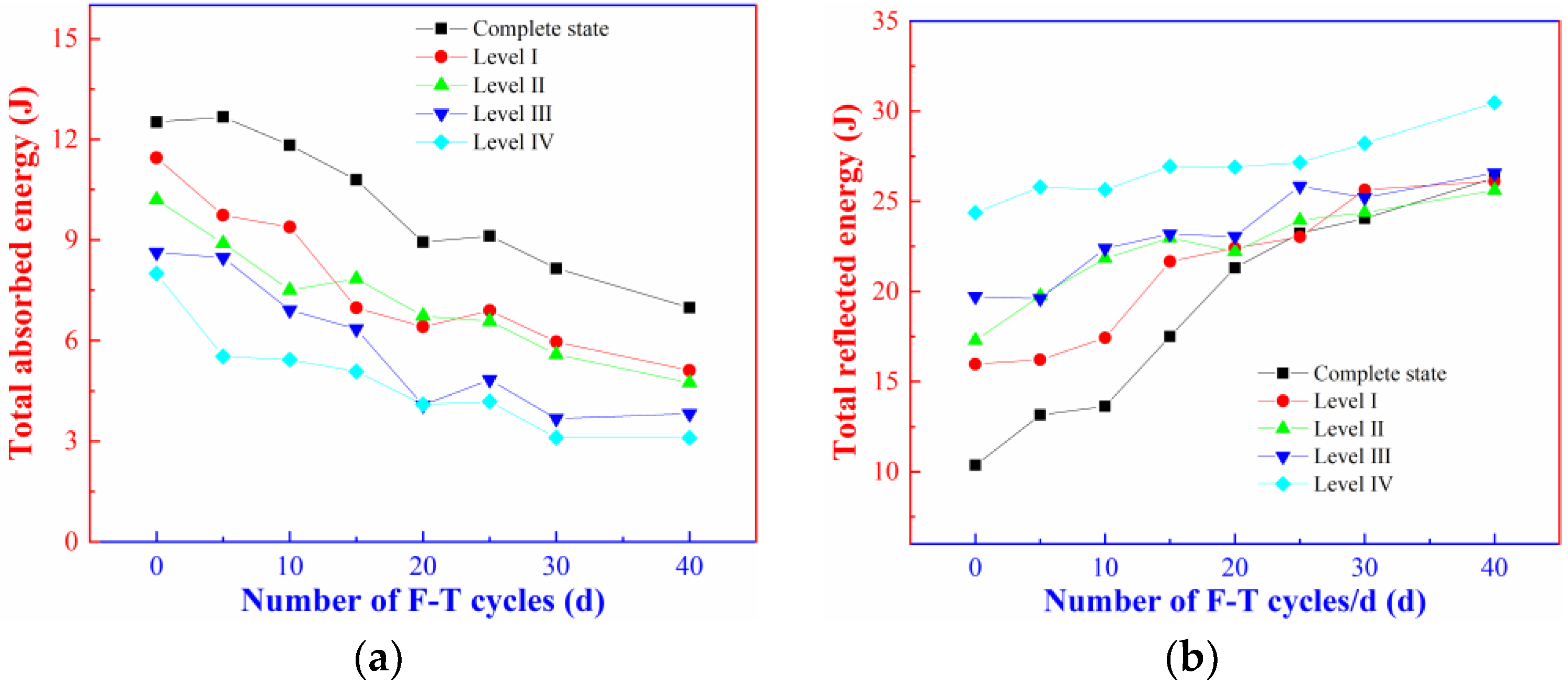

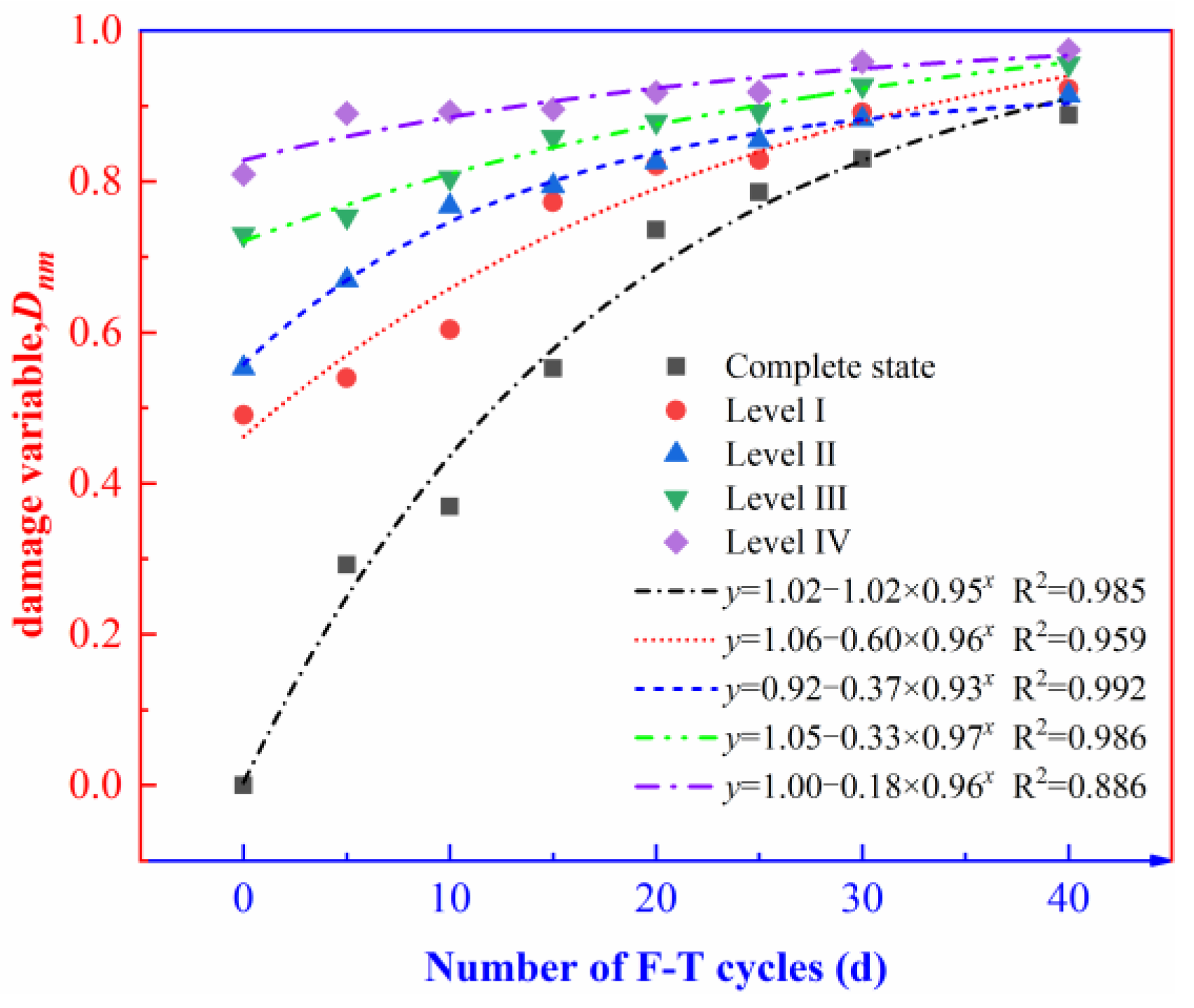
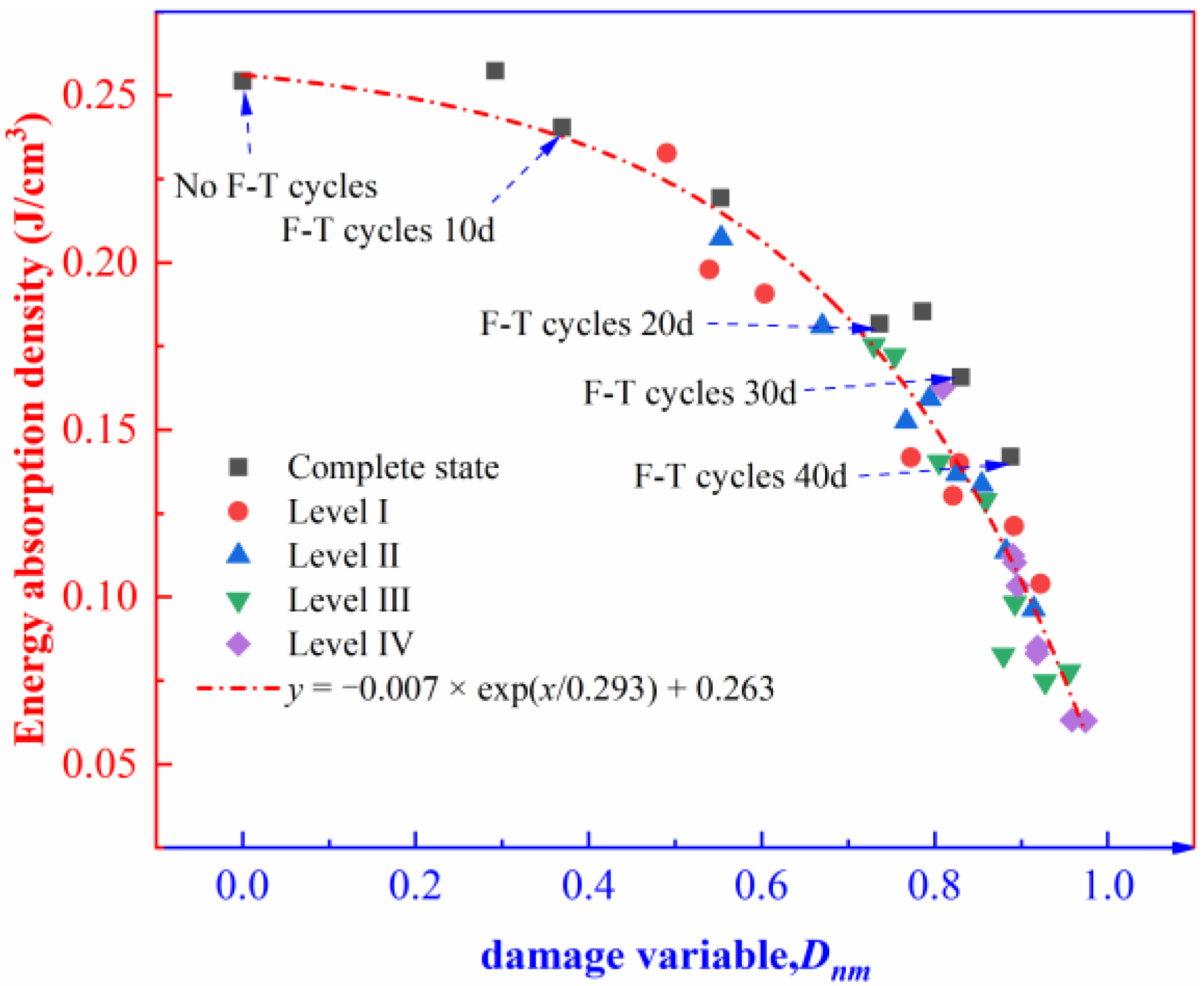
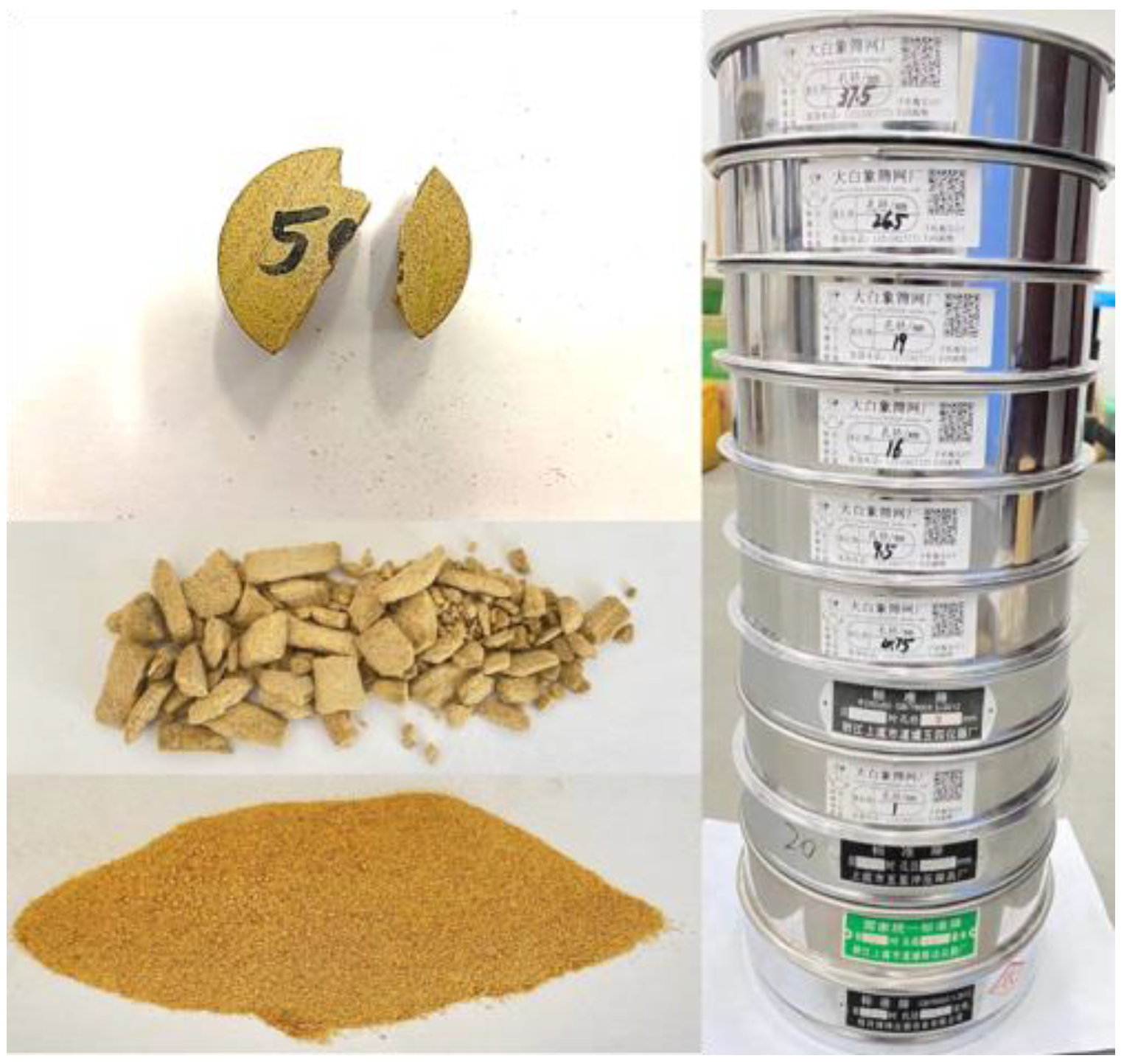

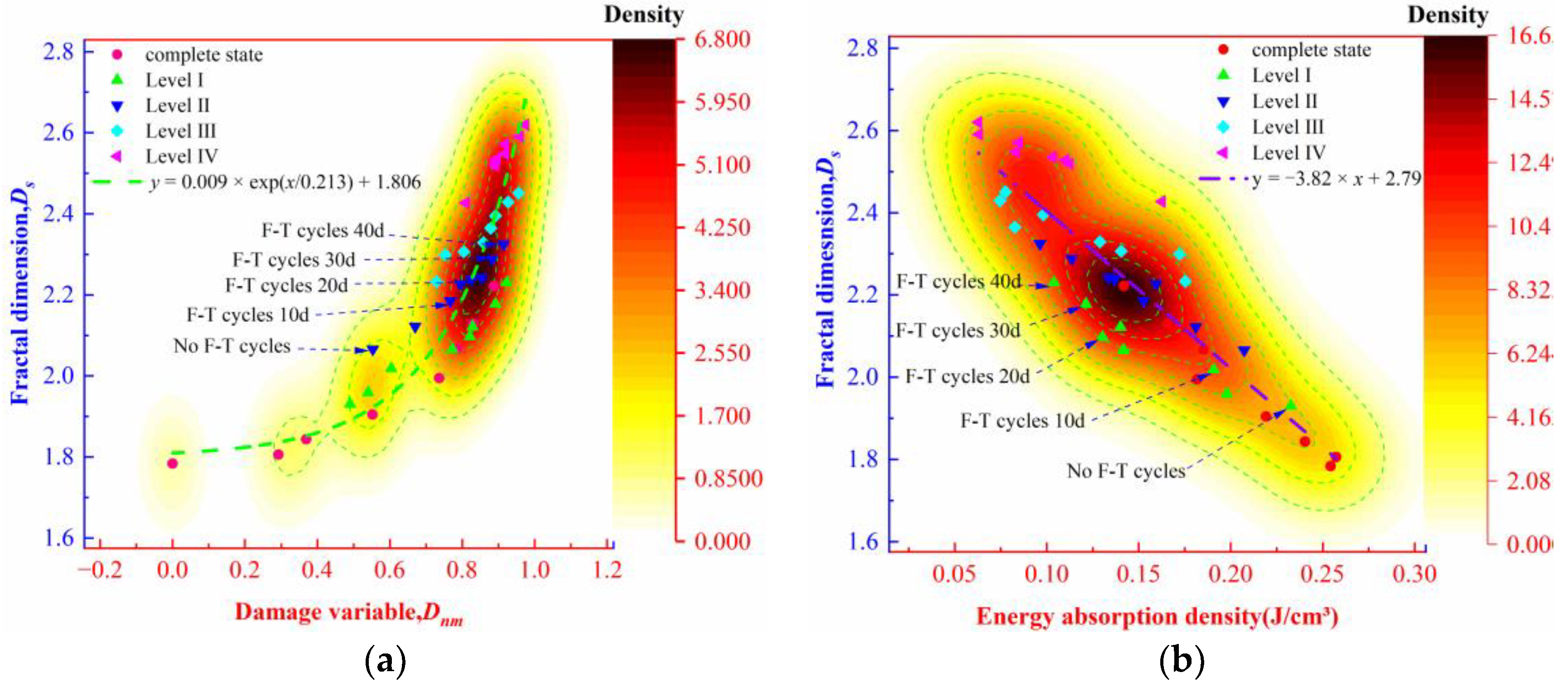
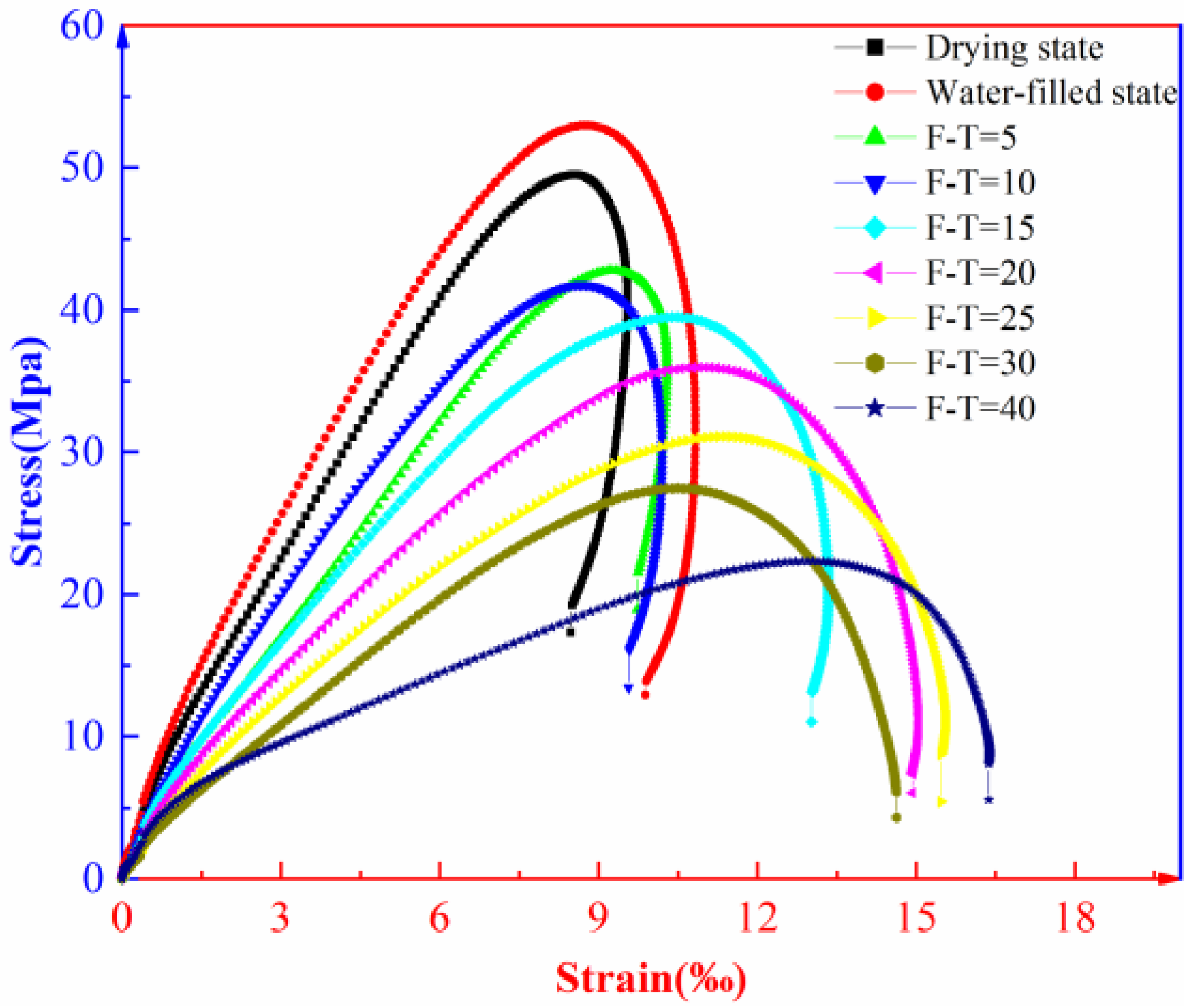

| Average Longitudinal Wave Velocity (m/s) | Saturation Density (g/cm3) | Drying Density (g/cm3) | Porosity (%) | Elastic Modulus (GPa) | Uniaxial Compressive Strength (MPa) |
|---|---|---|---|---|---|
| 1886 | 2.31 | 2.20 | 11.6 | 6.03 | 45.76 |
| Fitting Parameters | ||||
|---|---|---|---|---|
| Complete state | 1.02 | 1.02 | 0.95 | 0.985 |
| I | 1.06 | 0.60 | 0.96 | 0.959 |
| II | 0.92 | 0.37 | 0.93 | 0.992 |
| III | 1.05 | 0.33 | 0.97 | 0.986 |
| IV | 1.00 | 0.18 | 0.96 | 0.886 |
| Number of F-T Cycles n | Peak Strain (‰) | Peak Stress (MPa) | Average Strain Rate (1/s) |
|---|---|---|---|
| Drying state | 8.52 | 49.48 | 69.87 |
| Water-filled state | 8.74 | 52.96 | 70.01 |
| 5 | 9.26 | 42.76 | 72.98 |
| 10 | 8.70 | 41.74 | 76.73 |
| 15 | 10.48 | 39.49 | 88.85 |
| 20 | 10.89 | 35.95 | 93.95 |
| 25 | 11.38 | 31.09 | 96.49 |
| 30 | 10.49 | 27.44 | 73.73 |
| 40 | 12.94 | 22.33 | 101.12 |
Disclaimer/Publisher’s Note: The statements, opinions and data contained in all publications are solely those of the individual author(s) and contributor(s) and not of MDPI and/or the editor(s). MDPI and/or the editor(s) disclaim responsibility for any injury to people or property resulting from any ideas, methods, instructions or products referred to in the content. |
© 2022 by the authors. Licensee MDPI, Basel, Switzerland. This article is an open access article distributed under the terms and conditions of the Creative Commons Attribution (CC BY) license (https://creativecommons.org/licenses/by/4.0/).
Share and Cite
Jia, Y.; Bai, Y.; Xia, D.; Li, F.; Liang, B. Energy Dissipation and Damage Evolution during Dynamic Fracture of Muddy Siltstones Containing Initial Damage under the Freeze Thaw Effect. Materials 2023, 16, 120. https://doi.org/10.3390/ma16010120
Jia Y, Bai Y, Xia D, Li F, Liang B. Energy Dissipation and Damage Evolution during Dynamic Fracture of Muddy Siltstones Containing Initial Damage under the Freeze Thaw Effect. Materials. 2023; 16(1):120. https://doi.org/10.3390/ma16010120
Chicago/Turabian StyleJia, Yufei, Yuxin Bai, Dong Xia, Fuping Li, and Bing Liang. 2023. "Energy Dissipation and Damage Evolution during Dynamic Fracture of Muddy Siltstones Containing Initial Damage under the Freeze Thaw Effect" Materials 16, no. 1: 120. https://doi.org/10.3390/ma16010120
APA StyleJia, Y., Bai, Y., Xia, D., Li, F., & Liang, B. (2023). Energy Dissipation and Damage Evolution during Dynamic Fracture of Muddy Siltstones Containing Initial Damage under the Freeze Thaw Effect. Materials, 16(1), 120. https://doi.org/10.3390/ma16010120





